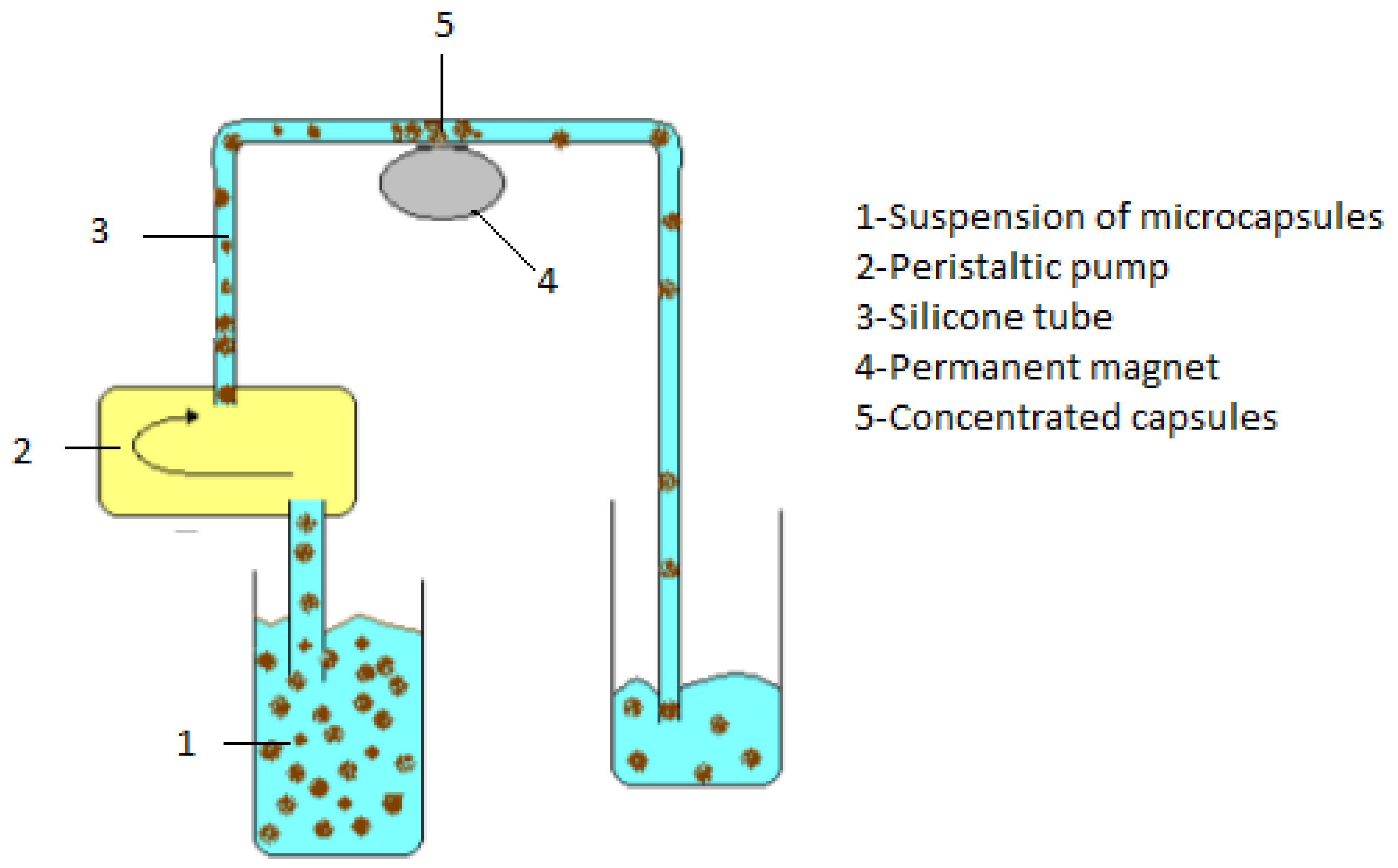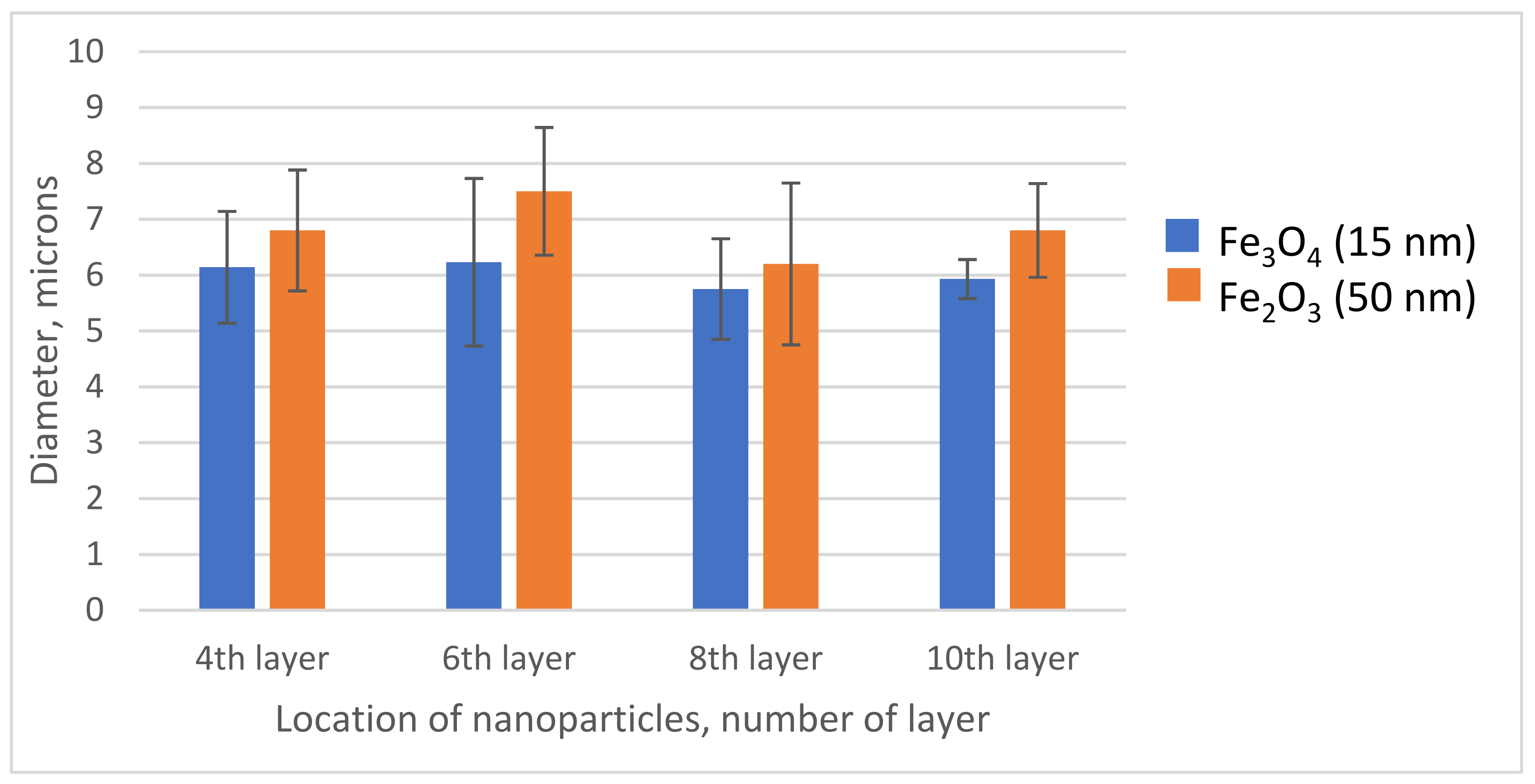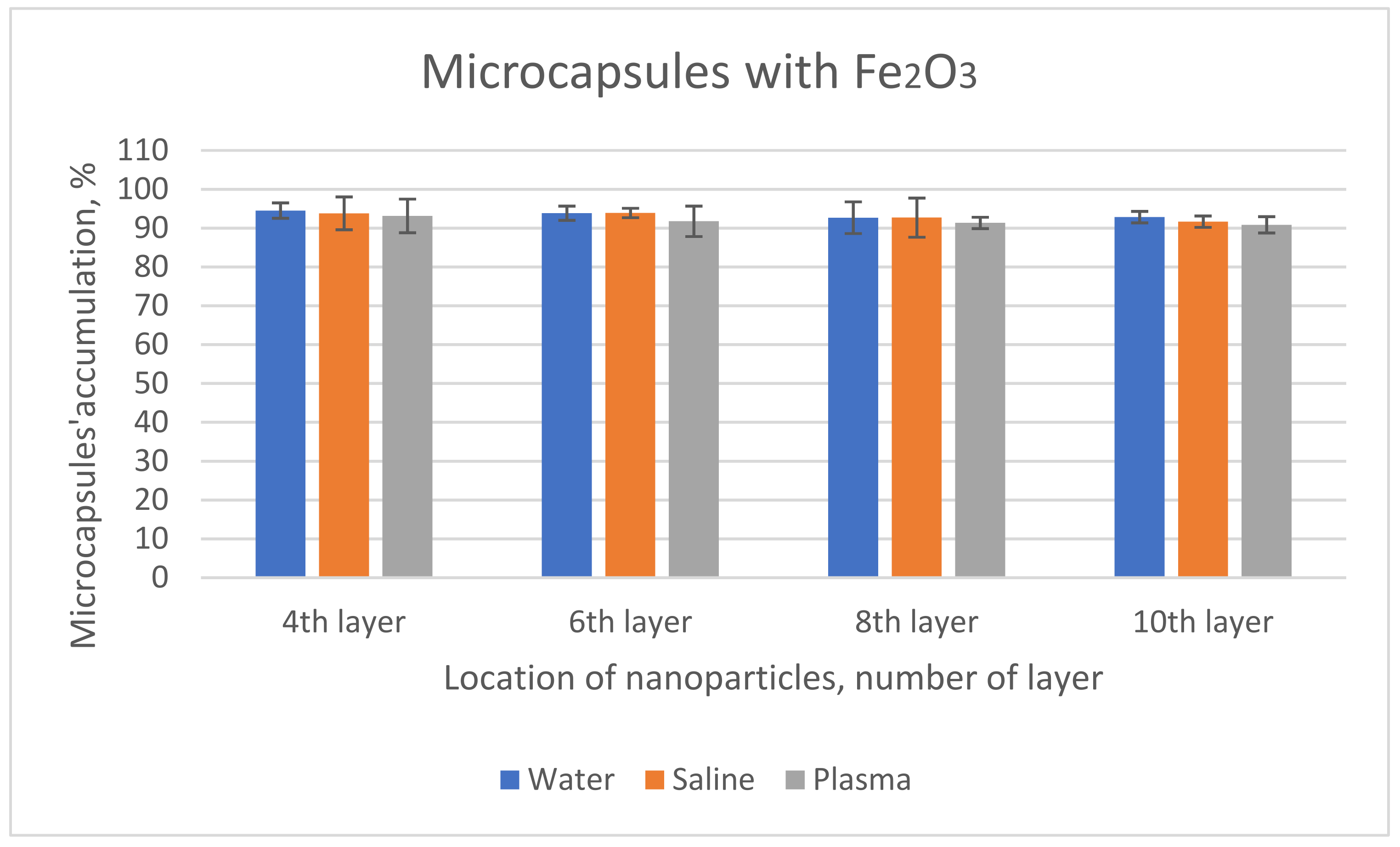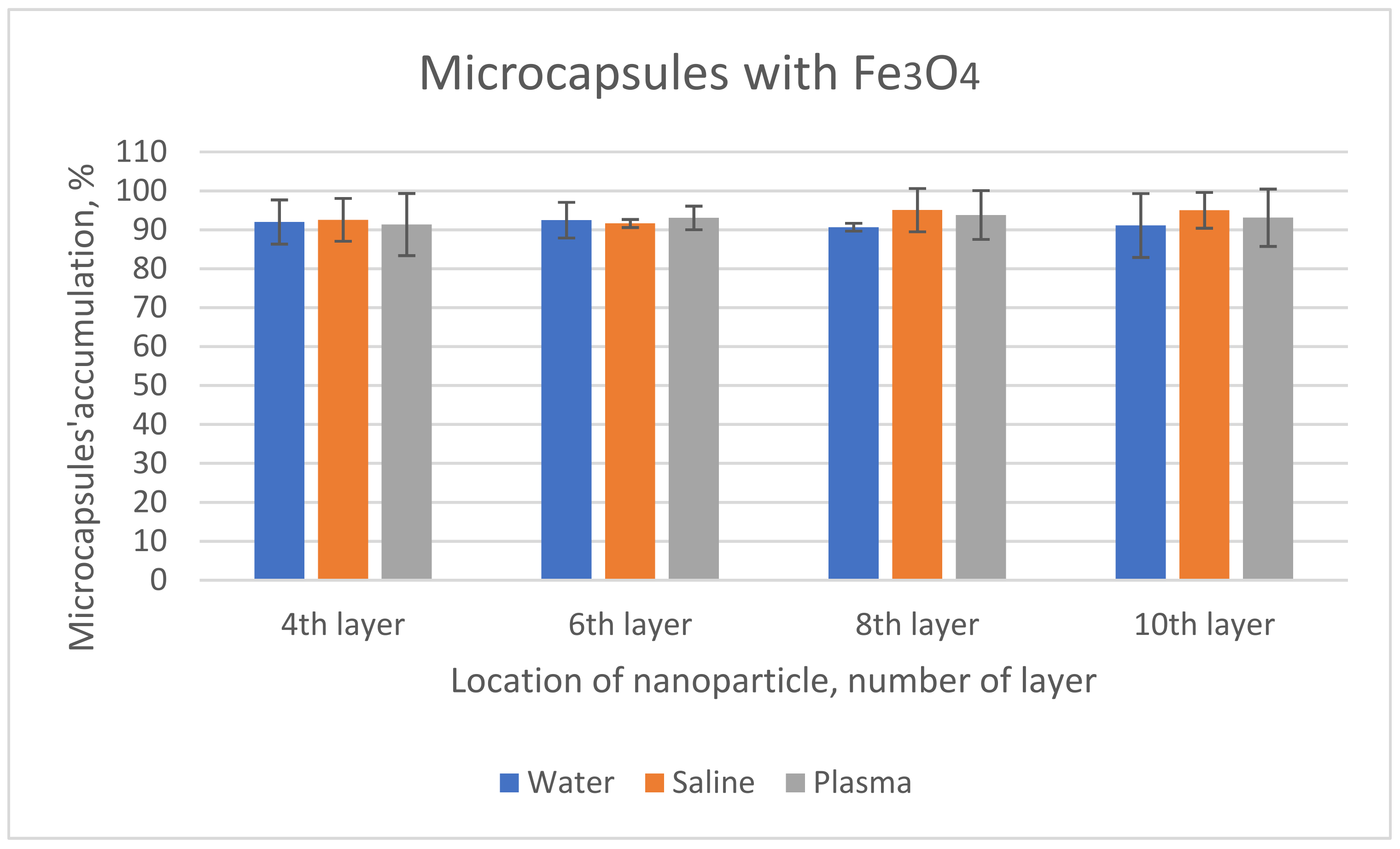Transport of Magnetic Polyelectrolyte Capsules in Various Environments
Abstract
:1. Introduction
2. Materials and Method
2.1. Materials
2.2. Capsule Preparation
2.3. Addition of Nanoparticles
2.4. Transportation
3. Analysis
3.1. Capsule Size Distribution
3.2. Iron Content
3.3. Accumulation/Depletion
- Acc is the accumulated percentage of capsules within the portion of the tube placed on the top of the magnet;
- Ci is the concentration of capsules at the entry point in the peristaltic pump;
- Cd is the concentration of the capsules after passing over the permanent magnet.
4. Results and Discussions
4.1. Capsules Containing Fe2O3
4.2. Capsules Containing Fe3O4
5. Conclusions
Author Contributions
Funding
Institutional Review Board Statement
Informed Consent Statement
Data Availability Statement
Acknowledgments
Conflicts of Interest
References
- Jain, K.K. Drug Delivery Systems in Methods in Molecular Biology, 2nd ed.; Humana Press: Basel, Switzerland, 2014. [Google Scholar]
- Siepmann, J.; Siegel, R.A.; Rathbone, M.J. Fundamentals and Applications of Controlled Release Drug Delivery; Springer: Cham, Switzerland, 2012. [Google Scholar]
- Eloy, J.O.; Marchetti, J.M.; Abriata, J.P. Nanocarriers for Drug Delivery: Concepts and Applications; Springer: Cham, Switzerland, 2021. [Google Scholar]
- Ruman, U.; Fakurazi, S.; Masarudin, M.J.; Hussein, M.Z. Nanocarrier-Based Therapeutics and Theranostics Drug Delivery Systems for Next Generation of Liver Cancer Nanodrug Modalities. Int. J. Nanomed. 2020, 15, 1437–1456. [Google Scholar] [CrossRef] [PubMed] [Green Version]
- Hossen, S.; Hossain, M.K.; Basher, M.K.; Mia, M.N.H.; Rahman, M.T.; Uddin, M.J. Smart nanocarrier-based drug delivery systems for cancer therapy and toxicity studies: A review. J. Adv. Res. 2018, 15, 1–18. [Google Scholar] [CrossRef] [PubMed]
- Jacob, J.; Haponiuk, J.T.; Thomas, S.; Gopi, S. Biopolymer based nanomaterials in drug delivery systems: A review. Mater. Today Chem. 2018, 9, 43–55. [Google Scholar] [CrossRef]
- Atanase, L.I. Micellar Drug Delivery Systems Based on Natural Biopolymers. Polymers 2021, 13, 477. [Google Scholar] [CrossRef] [PubMed]
- Jagtap, P.; Patil, K.; Dhatrak, P. Polyelectrolyte Complex for Drug Delivery in Biomedical Applications: A review. IOP Conf. Ser. Mater. Sci. Eng. 2021, 1183, 012007. [Google Scholar] [CrossRef]
- Shama, V.; Sundaramurthy, A. Multilayer capsules made of weak polyelectrolytes: A review on the preparation, functionalization and applications in drug delivery. Beilstein J. Nanotechnol. 2020, 11, 508–532. [Google Scholar] [CrossRef] [Green Version]
- Stoleru, E.; Vasile, C. Nucleic acids-based bionanomaterials for drug and gene therapy. In Polymeric Nanomaterials in Nanotherapeutics; Cornelia, V., Ed.; Elsevier: Amsterdam, The Netherlands, 2019; Chapter 6; pp. 235–260. [Google Scholar]
- Ruesing, J.; Rotan, O.; Gross-Heitfeld, C.; Mayer, C.; Epple, M. Nanocapsules of a cationic polyelectrolyte and nucleic acid for efficient cellular uptake and gene transfer. J. Mater. Chem. B 2014, 2, 4625–4630. [Google Scholar] [CrossRef] [Green Version]
- Wang, H.; Yang, B.; Sun, H. Pectin-Chitosan Polyelectrolyte Complex Nanoparticles for Encapsulation and Controlled Release of Nisin. Am. J. Polym. Sci. Technol. 2017, 3, 82–88. [Google Scholar] [CrossRef]
- Ji, F.; Li, J.; Qin, Z.; Yang, B.; Zhang, E.; Dong, D.; Wang, J.; Wen, Y.; Tian, L.; Yao, F. Engineering pectin-based hollow nanocapsules for delivery of anticancer drug. Carbohydr. Polym. 2017, 177, 86–96. [Google Scholar] [CrossRef]
- Roy, S.; Elbaz, N.M.; Parak, W.J.; Feliu, N. Biodegradable Alginate Polyelectrolyte Capsules as Plausible Biocompatible Delivery Carriers. ACS Appl. Biol. Mater. 2019, 2, 3245–3256. [Google Scholar] [CrossRef]
- Boi, S.; Rouatbi, N.; Dellacasa, E.; Di Lisa, D.; Bianchini, P.; Monticelli, O.; Pastorino, L. Alginate microbeads with internal microvoids for the sustained release of drugs. Int. J. Biol. 2020, 156, 454–461. [Google Scholar] [CrossRef] [PubMed]
- Morin-Crini, N.; Lichtfouse, E.; Torri, G.; Crini, G. Fundamentals and Applications of Chitosan. Sustain. Agric. Rev. 2019, 35, 49–123. [Google Scholar]
- Ejeromedoghene, O.; Oderinde, O.; Egejuru, G.; Adewuyi, A. Chitosan-drug encapsulation as a potential candidate for COVID-19 drug delivery systems: A review. JOTCS 2020, 7, 851–864. [Google Scholar] [CrossRef]
- Rinaudo, M.; Kil’deeva, N.R.; Babak, V.G. Surfactant-polyelectrolyte complexes on the basis of chitin. Russ. J. Gen. Chem. 2008, 78, 2239–2246. [Google Scholar] [CrossRef]
- Chen, W.; Zhou, S.; Ge, L.; Wu, W.; Jiang, X. Translatable High Drug Loading Drug Delivery Systems Based on Biocompatible Polymer Nanocarriers. Biomacromolecules 2018, 19, 1732–1745. [Google Scholar] [CrossRef]
- Zakharova, L.Y.; Vasilieva, E.A.; Gaynanova, G.A.; Mirogorodska, A.B.; Ibragimova, A.R.; Salnikov, V.V.; Uchegbu, I.F.; Konovalov, A.I.; Zuev, Y.F. The polyacrylic acid/modified chitosan capsules with tunable release of small hydrophobic probe and drug. Colloids Surf. 2015, 471, 93–100. [Google Scholar] [CrossRef]
- Kinnane, C.R.; Such, G.K.; Caruso, F. Tuning the Properties of Layer-by-Layer Assembled Poly(acrylic acid) Click Films and Capsules. Macromolecules 2011, 44, 1194–1202. [Google Scholar] [CrossRef]
- Burke, N.A.D.; Mazumder, M.A.J.; Hanna, M.; Stover, H.D. Polyelectrolyte Complexation Between Poly(methacrylic acid, sodium salt) and Poly(diallyldimethylammonium chloride) or Poly[2-(methacryloyloxyethyl)trimethylammonium chloride]. J. Polym. Sci. Part A Polym. Chem. 2007, 45, 4129–4143. [Google Scholar] [CrossRef]
- Skirtach, A.G.; Yashchenok, A.M.; Mohwald, H. Encapsulation, release and applications of LbL polyelectrolyte multilayer capsules. Chem. Commun. 2011, 47, 12736–12746. [Google Scholar] [CrossRef]
- Lilienthal, S.; Fischer, A.; Liao, W.-C.; Cazelles, R.; Willner, I. Single and Bilayer Polyacrylamide Hydrogel-Based Microcapsules for the Triggered Release of Loads, Logic Gate Operations, and Intercommunication between Microcapsules. ACS Appl. Mater. Interfaces 2020, 12, 31124–31136. [Google Scholar] [CrossRef]
- Antipov, A.A.; Sukhorukov, G.B. Polyelectrolyte multilayer capsules as vesicles with tunable permeability. Adv. Colloid Interface Sci. 2004, 11, 49–61. [Google Scholar] [CrossRef]
- Da Silva Abreu, A.; Carvalho, J.A.; Tedesco, A.C.; Beltrame, M.; Simioni, A.R. Fabrication of polyelectrolyte microspheres using porous manganese carbonate as sacrifical template for drug delivery application. J. Mater. Res. 2019, 34, 1353–1362. [Google Scholar] [CrossRef]
- Cui, X.; Chen, H.; Ye, Q.; Cui, X.; Cui, X.; Cui, H.; Shen, G.; Lin, J.; Sun, Y. Porous Titanium Dioxide Sphere for Drug Delivery and Sustained Release. Front. Mater. 2021, 8, 204. [Google Scholar] [CrossRef]
- Yang, Q.; Li, L.; Zhao, F.; Wang, Y.; Ye, Z.; Hua, C.; Liu, Z.; Bohnic, K.; Guo, X. Spherical Polyelectrolyte Brushes as Templates to Prepare Hollow Silica Spheres Encapsulating Metal Nanoparticles. Nanomaterials 2020, 10, 799. [Google Scholar] [CrossRef] [Green Version]
- Nguyen, N.T.; Dao, T.H.; Truong, T.T.; Nguyen, T.M.T.; Pham, T.D. Adsorption characteristic of ciprofloxacin antibiotic onto synthesized alpha alumina nanoparticles with surface modification by polyanion. J. Mol. Liq. 2020, 309, 113150–113158. [Google Scholar] [CrossRef]
- Agdel-Bary, A.S.; Tolan, D.A.; Nassar, M.Y.; Taketsugu, T.; El-Nahas, A.M. Chitosan, magnetite, silicon dioxide, and graphene oxide nanocomposites: Synthesis, characterization efficiency as cisplatin drug delivery, and DFT calculations. Int. J. Biol. 2020, 154, 621–633. [Google Scholar]
- Anirudhan, T.S.; Chithra Sekhar, V.; Nair, S.S. Polyelectrolyte complexes of carboxymethyl chitosan/alginate based drug carrier for targeted and controlled release of dual drug. J. Drug Deliv. Sci. Technol. 2019, 51, 569–582. [Google Scholar] [CrossRef]
- Langer, R.; Peppas, N. Chemical and physical structure of polymers as carriers for controlled release of bioactive agents: A review. J. Macromol. Sci. Phys. 1983, 23, 61–126. [Google Scholar] [CrossRef]
- Antipina, M.N.; Sukhorukov, G.B. Remote control over guidance and release properties of composite polyelectrolyte-based capsules. Adv. Drug Deliv. Rev. 2011, 63, 716–729. [Google Scholar] [CrossRef]
- Delcea, M.; Mohwald, H.; Skirtach, A.G. Stimuli-responsive LbL capsules and nanoshells for drug delivery. Adv. Drug Deliv. Rev. 2011, 63, 730–747. [Google Scholar] [CrossRef]
- Fomina, N.; Sankaranarayanan, J.; Almutairi, A. Photochemical mecanisms of light-triggered release from nanocarriers. Adv. Drug Deliv. Rev. 2012, 64, 1005–1020. [Google Scholar] [CrossRef] [PubMed] [Green Version]
- Lomova, M.V.; Brichkina, A.I.; Kiryukhin, M.V.; Vasina, E.N.; Pavlov, A.M.; Gorin, D.A.; Sukhorukov, G.B.; Antipina, M.N. Multilayer Capsules Of Bovine Serum Albumin and Tannic Acid for Controlled Release by Enzymatic Degradation. ACS Appl. Mater. Interfaces 2015, 7, 11732–11740. [Google Scholar] [CrossRef] [PubMed]
- Gaponik, N.; Radtchenko, I.L.; Sukhorukov, G.B.; Rogach, A.L. Luminescent Polymer Microcapsules Addressable by a Magnetic Field. Langmuir 2004, 20, 1449–1452. [Google Scholar] [CrossRef]
- Hu, S.H.; Tsai, C.H.; Liao, C.F.; Liu, D.M.; Chen, S.Y. Controlled Rupture of Magnetic Polyelectrolyte Microcapsules for Drug Delivery. Langmuir 2008, 24, 11811–11818. [Google Scholar] [CrossRef]
- Fang, M.; Grant, P.S.; McShane, M.J.; Sukhorukov, G.B.; Golub, V.O.; Lvov, Y.M. Magnetic Bio/Nanoreactor with Multilayer Shells of Glucose Oxidase and Inorganic Nanoparticles. Langmuir 2002, 18, 6338–6344. [Google Scholar] [CrossRef]
- Liu, J.F.; Jang, B.; Issadore, D.; Tsourkas, A. Use of magnetic fields and nanoparticles to trigger drug release and improve tumor targeting. Wiley Interdiscip. Rev. Nanomed. Nanobiotechnol. 2019, 11, e1571. [Google Scholar] [CrossRef]
- Carregal-Romero, S.; Guardia, P.; Yu, X.; Hartmann, R.; Pellegrino, T.; Parak, W.J. Magnetically triggered release of molecular cargo from iron oxide nanoparticle loaded microcapsules. Nanoscale 2015, 7, 570–576. [Google Scholar] [CrossRef] [Green Version]
- Ridi, F.; Bonini, M.; Baglioni, P. Magneto-responsive nanocomposites: Preparation and integration of magnetic nanoparticles into films, capsules, and gels. Adv. Colloid Interface Sci. 2014, 207, 3–13. [Google Scholar] [CrossRef]
- Martina, M.-S.; Fortin, J.-P.; Fornier, L.; Menager, C.; Gazeau, F.; Clement, O.; Lesieur, S. Magnetic Targeting of Rhodamine-Labeled Superparamagnetic Liposomes to Solid Tumors: In Vivo Tracking by Fibered Confocal Fluorescence Microscopy. Mol. Imaging 2007, 6, 140–146. [Google Scholar] [CrossRef]
- Yang, H.Y.; Li, Y.; Lee, S.S. Multifunctional and Stimuli-Responsive Magnetic Nanoparticle-Based Delivery Systems for Biomedical Applications. Adv. Therap. 2018, 1, 1800011. [Google Scholar] [CrossRef]
- Nishida, K. Recent Advances in Lipid-Based Drug Delivery. Pharmaceutics 2021, 13, 926. [Google Scholar] [CrossRef] [PubMed]
- Fiejdasz, S.; Gilarska, A.; Horak, W.; Radziszewska, A.; Straczek, T.; Szuwarzynski, M.; Nowakowska, M.; Kapusta, C. Structurally stable hybrid magnetic materials based on natural polymers-preparation and characterization. J. Mater. Sci. Technol. 2021, 15, 3149–3160. [Google Scholar] [CrossRef]
- Tataru, G.; Popa, M.; Desbrieres, J. Magnetic microparticles based on natural polymers. Int. J. Pharm. 2011, 404, 83–93. [Google Scholar] [CrossRef] [PubMed]
- Mannu, R.; Karthikeyan, V.; Velu, N.; Arumugam, C.; Roy, V.A.L.; Gopalan, A.-J.; Saianand, G.; Sonar, P.; Lee, K.-P.; Kim, W.-J.; et al. Polyethylene Glycol Coated Magnetic Nanoparticles: Hybrid Nanofluid Formulation, Properties and Drug Delivery Prospects. Nanomaterials 2021, 1, 440. [Google Scholar] [CrossRef] [PubMed]
- Al-Musawi, S.; Ibraheem, S.; Mahdi, S.A.; Albukhaty, S.; Haider, A.J.; Kadhim, A.A.; Kadhim, K.A.; Kadhim, H.A.; Al-Karagoly, H. Smart Nanoformulation Based on Polymeric Magnetic Nanoparticles and Vincrisitine Drug: A Novel Therapy for Apoptotic Gene Expression in Tumors. Life 2021, 11, 71. [Google Scholar] [CrossRef] [PubMed]
- Luo, D.; Poston, R.N.; Gould, D.J.; Sukhorukov, G.B. Magnetically targetable microcapsules display subtle changes in permeability and drug release in response to a biologically comppatible low frequency alternating magnetic field. Mater. Sci. Eng. C 2019, 94, 647–655. [Google Scholar] [CrossRef] [PubMed]
- Saini, R.K.; Chouhan, R.; Bagri, L.P.; Bajpai, A.K. Strategies of Targeting Tumors and Cancers. J. Cancer Res. Updates 2012, 1, 129–152. [Google Scholar]
- Zebli, B.; Susha, A.S.; Sukhorukov, G.B.; Rogach, A.L.; Parak, W.J. Magnetic Targeting and Cellular Uptake of Polymer Microcapsules Simultaneously Functionalized with Magnetic and Luminescent Nanocrystals. Langmuir 2005, 21, 4262–4265. [Google Scholar] [CrossRef]
- Ochs, M.; Carregal-Romero, S.; Rejman, J.; Braeckmans, K.; De Smedt, S.C.; Parak, W.J. Light-Addressable Capsules as Caged Compound Matrix for Controlled Triggering of Cytosolic Reactions. Angew. Chem. Int. Ed. 2013, 52, 695–699. [Google Scholar] [CrossRef]
- Kolesnikova, T.A.; Akchurin, G.G.; Portnov, S.A.; Khomutov, G.B.; Akchurin, G.G.; Naumova, O.G.; Sukhorukov, G.B.; Gorin, D.A. Visualization of magnetic microcapsules in liquid by optical coherent tomography and control of their arrangement via external magnetic field. Laser Phys. Lett. 2012, 9, 643–648. [Google Scholar] [CrossRef]
- Stavarache, C.E. Paniwnyk, Controlled rupture of magnetic LbL polyelectrolyte capsules and subsequent release of contents employing high intensity focused ultrasound. J. Drug. Deliv. Sci. Technol. 2018, 45, 60–69. [Google Scholar] [CrossRef]
- Stavarache, C.; Vinatoru, M.; Mason, T. The Effect of Focused Ultrasound on Magnetic Polyelectrolyte Capsules Loaded with Dye When Suspended in Tissue-Mimicking Gel. Curr. Drug Deliv. 2019, 16, 355–363. [Google Scholar] [CrossRef]
- Liu, Y.-L.; Chen, D.; Shang, P.; Yin, D.-C. A review of magnet systems for targeted drug delivery. J. Control. Release 2019, 302, 90–104. [Google Scholar] [CrossRef] [PubMed]
- Barnsley, L.C.; Carugo, D.; Aron, M.; Stride, E. Understanding the dynamics of superparamagnetic particles under the influence of high field gradient arrays. Phys. Med. Biol. 2017, 62, 2333–2360. [Google Scholar] [CrossRef] [PubMed]
- Sharma SSingh, U.; Katiyar, V.K. Magnetic field effect on flow parameters of blood along with magnetic particles in a cylindrical tube. J. Magn. Magn. Mater. 2015, 377, 395–401. [Google Scholar] [CrossRef]
- Gunasekera, U.A.; Pankhurst, Q.A.; Douek, M. Imaging applications of nanotechnology in cancer. Target. Oncol. 2009, 4, 169–181. [Google Scholar] [CrossRef]
- Entezar-Almahdi, E.; Mohammadi-Samani, S.; Tayebi, L.; Farjadian, F. Recent Advances in Designing 5-Fluorouracil Delivery Systems: A Stepping Stone in the Safe Treatment of Colorectal Cancer. Int. J. Nanomed. 2020, 15, 5445–5458. [Google Scholar] [CrossRef]
- Lince, F.; Bolognesi, S.; Stella, B.; Marchisio, D.L.; Dosio, F. Preparation of polymer nanoparticles loaded with doxorubicin for controlled drug delivery. Chem. Eng. Res. Des. 2011, 89, 2410–2419. [Google Scholar] [CrossRef]
- Babos, G.; Biro, E.; Meiczinger, M.; Feczko, T. Dual Drug Delivery of Sorafenib and Doxorubicin from PLGA and PEG-PLGA Polymeric Nanoparticles. Polymers 2018, 10, 895. [Google Scholar] [CrossRef] [Green Version]
- Manshadi, M.K.; Saadat, M.; Mohammadi, M.; Shamsi, M.; Dejam, M.; Kamali, R.; Sanati-Nezhad, A. Delivery of magnetic micro/nanoparticles and magnetic-based drug/cargo into arterial flow for targeted therapy. Drug Deliv. 2018, 25, 1963–1973. [Google Scholar] [CrossRef] [Green Version]
- Seliger, C.; Jurgons, R.; Wiekhorst, F.; Eberbeck, D.; Trahms, L.; Iro, H.; Alexiou, C. In vitro investigation of the behaviour of magnetic particles by a circulating artery model. J. Magn. Magn. Mater. 2007, 311, 358–362. [Google Scholar] [CrossRef]
- Opoku, A.; Tabil, L.G.; Crerar, B. Rheological and physical properties of bovine plasma fibriogen-enriched plasma. Presented at the CSAE/SCGR 2005 Meeting, Winnipeg, Manitoba, 26–29 June 2005. [Google Scholar]
- Howell, N.K.; Lawrie, R.A. Functional aspects of blood plasma proteins: V. Viscosity. Int. J. Food Sci. Technol. 2007, 22, 145–151. [Google Scholar] [CrossRef]
- Wicke, W.; Ahmadzadeh, A.; Jamali, V.; Schober, R.; Unterweger, H.; Alexiou, C. Molecular Communication using Magnetic Nanoparticles. In Proceedings of the 2018 IEEE Wireless Communications and Networking Conference (WCNC), Barcelona, Spain, 15–18 April 2018. [Google Scholar]





| Location of Nanoparticles | Type of Nanoparticle | |
|---|---|---|
| Fe3O4 (Ø 15 nm) | Fe2O3 (Ø 50 nm) | |
| 4th layer | 1.75 | 2.31 |
| 6th layer | 1.56 | 2.36 |
| 8th layer | 1.69 | 1.87 |
| 10th layer | 1.19 | 1.71 |
Publisher’s Note: MDPI stays neutral with regard to jurisdictional claims in published maps and institutional affiliations. |
© 2022 by the authors. Licensee MDPI, Basel, Switzerland. This article is an open access article distributed under the terms and conditions of the Creative Commons Attribution (CC BY) license (https://creativecommons.org/licenses/by/4.0/).
Share and Cite
Stavarache, C.; Vinatoru, M.; Mason, T. Transport of Magnetic Polyelectrolyte Capsules in Various Environments. Coatings 2022, 12, 259. https://doi.org/10.3390/coatings12020259
Stavarache C, Vinatoru M, Mason T. Transport of Magnetic Polyelectrolyte Capsules in Various Environments. Coatings. 2022; 12(2):259. https://doi.org/10.3390/coatings12020259
Chicago/Turabian StyleStavarache, Carmen, Mircea Vinatoru, and Timothy Mason. 2022. "Transport of Magnetic Polyelectrolyte Capsules in Various Environments" Coatings 12, no. 2: 259. https://doi.org/10.3390/coatings12020259





